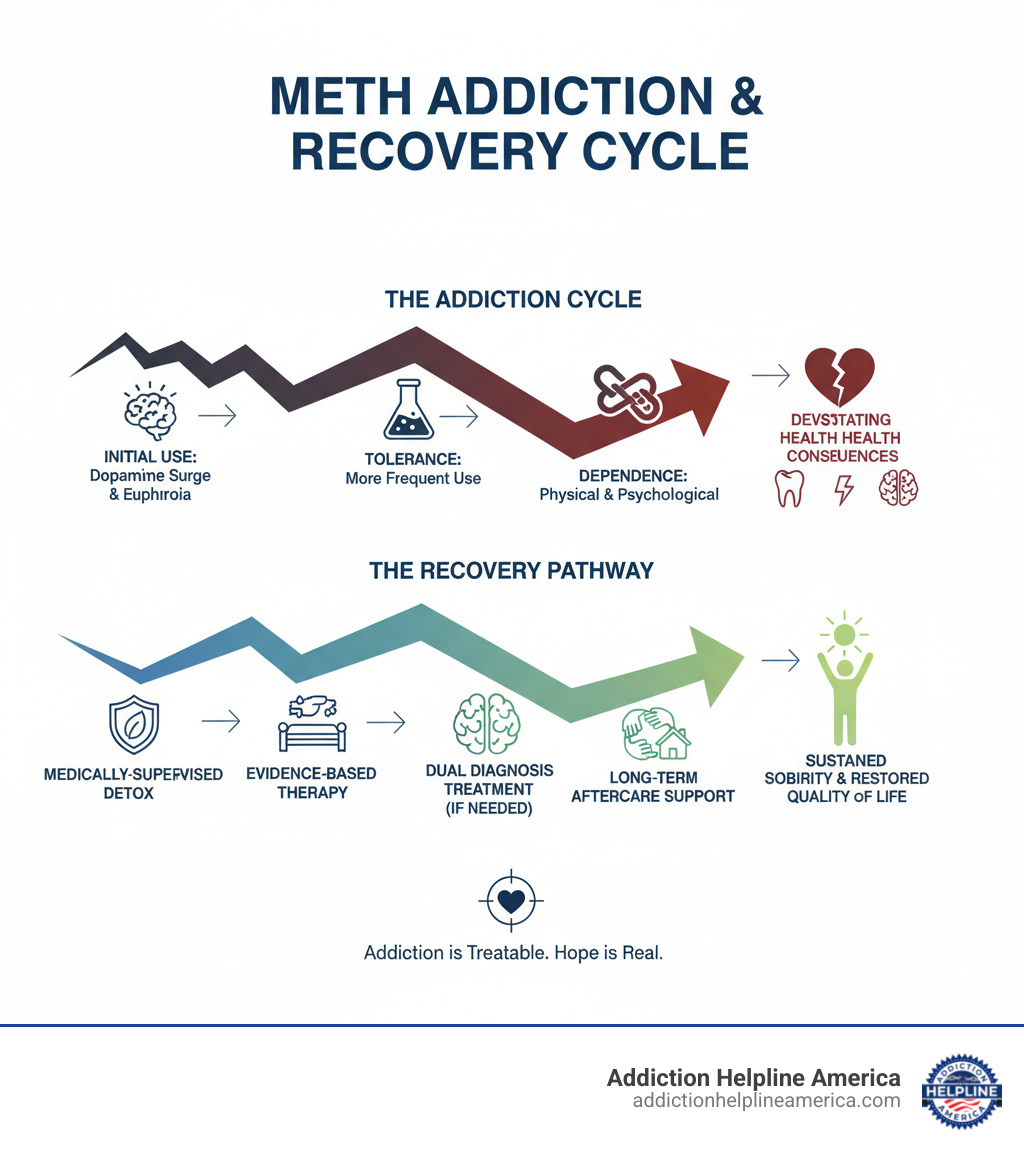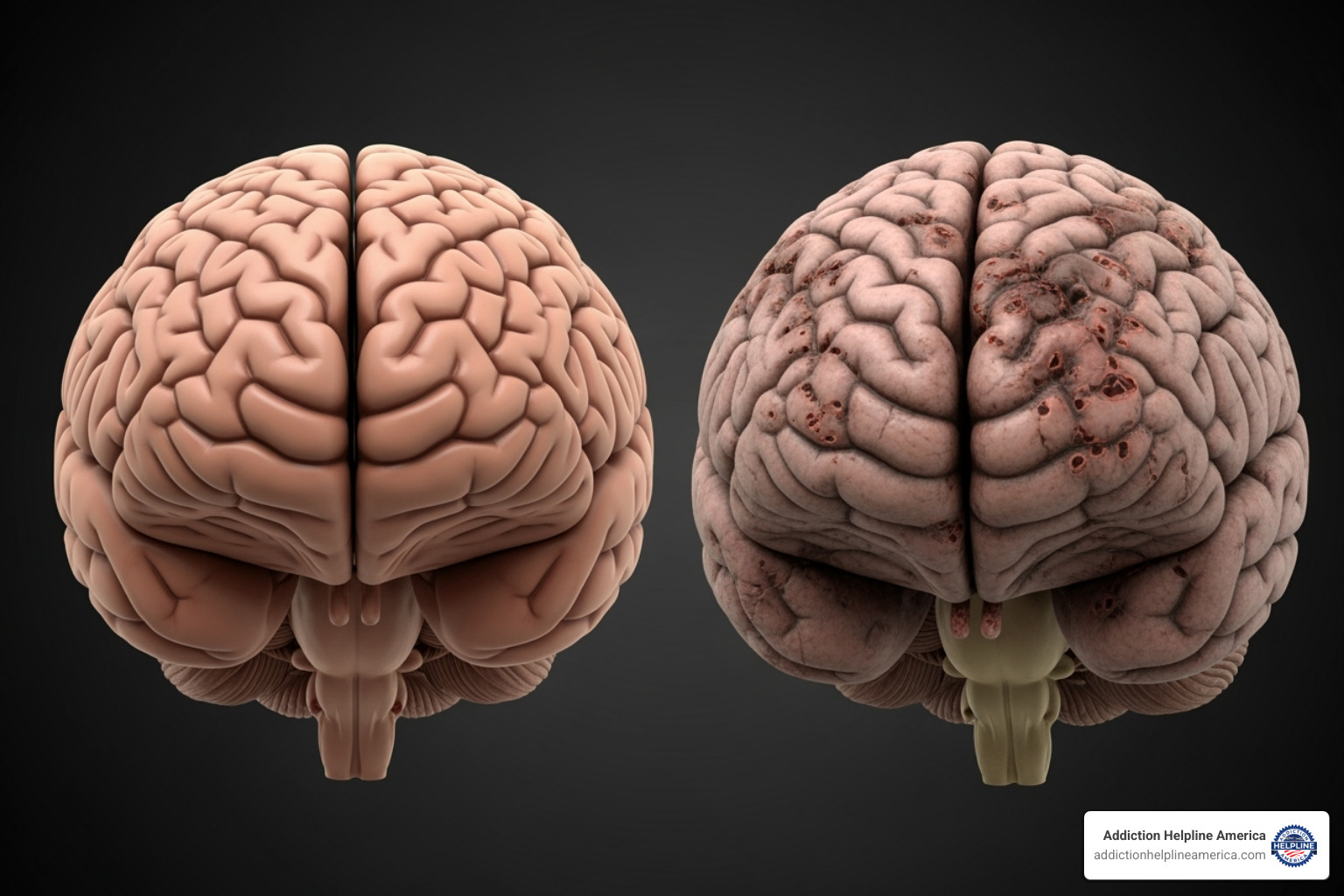Your Journey to a Healthier Life Starts Here
Free Insurance Verification
Verify Your Treatment Coverage
Verify Your Treatment Coverage
Meth Addiction Treatment offers a clear path to healing through medically-supervised detox, evidence-based therapies, and long-term support. While no FDA-approved medications exist specifically for meth addiction yet, promising research is underway, and other medications can effectively manage withdrawal symptoms.
Methamphetamine is a powerful stimulant that affects the central nervous system. In 2022, an estimated 2.7 million Americans used methamphetamine, with 1.8 million having a methamphetamine use disorder. The most important thing to know is that addiction is a treatable brain disease, not a moral failing. Recovery is absolutely possible.
Effective treatment addresses the physical, psychological, and underlying issues that fuel addiction. Despite the devastating consequences of meth use—from severe health problems to psychosis—people who complete treatment have recovery rates similar to those for other drug addictions. The brain can heal, relationships can be restored, and life can get better.
At Addiction Helpline America, we guide individuals and families through the recovery process, connecting them with evidence-based Meth Addiction Treatment programs custom to their unique needs. Our team of addiction specialists is here to provide compassionate, confidential support 24/7.

Methamphetamine, or meth, is a highly destructive Schedule II stimulant with an extremely high potential for abuse and dependence. Understanding its effects is crucial for recognizing when someone needs Meth Addiction Treatment.

Meth triggers a massive dopamine flood in the brain, creating intense euphoria and energy. However, this comes at a devastating price. Short-term use can cause a dangerously irregular heartbeat, high blood pressure, and seizures. Long-term, the consequences are even more severe.
For more details, the National Institute on Drug Abuse provides extensive scientific research on methamphetamine.
Recognizing the signs of meth use is the first step toward recovery. Look for a combination of these changes:

Take the first step towards a healthier life! Call now to connect with our compassionate team and start your recovery journey today. Your path to healing awaits!
Our recovery specialists are available 24/7 to provide support, and all calls are confidential and free. Reach out anytime – we’re here to help!
These mental and emotional symptoms signal an urgent need for professional Meth Addiction Treatment:
If these symptoms are familiar, professional help is critical. You can find more information about recognizing addiction to better understand these warning signs.
Effective Meth Addiction Treatment is a comprehensive journey, not a single event. It follows a continuum of care, starting with a thorough assessment to create an individualized treatment plan that addresses your unique medical, psychological, and social needs. This personalized approach is the key to a successful recovery.

Getting meth out of your system is the first hurdle. Medically-supervised detox is essential because while meth withdrawal is not typically life-threatening like alcohol withdrawal, the psychological distress can be extreme, leading to risks of self-harm.
Withdrawal symptoms usually begin within 2-4 days of last use and can be intense. Common symptoms include:
In a professional detox setting, which typically lasts 7-10 days, healthcare professionals monitor you 24/7 to manage these symptoms, ensuring your safety and comfort.
Currently, there are no FDA-approved medications specifically for methamphetamine addiction. However, this does not mean medication has no role in recovery.
Clinicians often use medications off-label for symptom management. Antidepressants, anti-anxiety medications, and sleep aids can help manage the severe depression, agitation, and insomnia common during withdrawal. In cases of psychosis, antipsychotics may be used to ensure safety.
Exciting new research is changing the landscape. A combination of naltrexone plus bupropion has proven effective in a major clinical trial for treating moderate to severe methamphetamine use disorder. Bupropion helps ease withdrawal-related dysphoria, while naltrexone reduces cravings and the drug’s euphoric effects. Other medications are also being studied, offering more hope for the future. You can explore the latest developments in the Overview of current research from the National Institute on Drug Abuse.
After detox, the real work of recovery begins with evidence-based behavioral therapies. These are the tools that help you understand your addiction, change destructive patterns, and build a new life. Choosing the right level of care is the first step.

Deciding between inpatient and outpatient care is best done with professional guidance. Inpatient (residential) treatment provides 24/7 support in a structured, trigger-free environment, ideal for severe addiction or unstable home situations. Outpatient programs offer flexibility, allowing you to live at home while attending scheduled therapy. This works well for those with milder addiction or as a step-down from inpatient care.
| Feature | Inpatient Rehab | Outpatient Rehab |
|---|---|---|
| Setting | Live at the facility 24/7 | Live at home, attend sessions |
| Structure | Highly structured, intensive schedule | Flexible schedule, allows for daily obligations |
| Supervision | Round-the-clock medical and emotional support | Regular sessions, less direct supervision |
| Environment | Trigger-free, removes individual from daily stressors | Integrates treatment with real-world environment |
| Duration | Typically 30–90 days, sometimes longer | Varies (e.g., 10–12 hours/week), can be long-term |
| Ideal For Whom | Severe addiction, co-occurring disorders, unstable housing | Milder addiction, strong home support, work/school needs |
| Types | Residential treatment, long-term rehab | Partial Hospitalization (PHP), Intensive Outpatient (IOP) |

Take the first step towards a healthier life! Call now to connect with our compassionate team and start your recovery journey today. Your path to healing awaits!
Our recovery specialists are available 24/7 to provide support, and all calls are confidential and free. Reach out anytime – we’re here to help!
Research has proven these therapies help people overcome meth addiction:
It’s very common for meth addiction to co-exist with mental health disorders like depression, anxiety, PTSD, or bipolar disorder. This is called a dual diagnosis. Treating the addiction while ignoring the mental health issue (or vice-versa) is ineffective. Integrated treatment, which addresses both conditions simultaneously, is essential for lasting recovery. This may involve a combination of therapy (like CBT) and appropriate medications to stabilize mental health. For more information, see these SAMHSA resources on Mental Health.
Taking the first step toward Meth Addiction Treatment is often the hardest, but it’s also the bravest. Reaching out for support is not a sign of weakness; it’s a sign of strength. Addiction is a medical condition, and you don’t have to face it alone.
If you’re struggling, recovery is within your reach. Start with an honest self-assessment. Have you tried to quit but couldn’t? Do cravings consume your thoughts? If so, it’s time to seek help. Talking to a doctor or therapist is a great step. If you don’t have one, we are here for you.
Our free, confidential helpline at Addiction Helpline America is available 24/7. Our admissions navigators will listen without judgment, answer your questions, and help you understand your treatment options. We can even verify your insurance over the phone. Don’t let cost be a barrier; many insurance plans are accepted, and other financing options exist. Contact us through Addiction Helpline America’s National Helpline and Treatment Locator.
Watching a loved one struggle is heartbreaking. Your support is crucial, but it must be approached correctly. When you’re ready to talk, choose a calm moment and speak with empathy, not anger. Focus on specific behaviors you’ve observed and express your concern. Avoid blame and judgment.
Setting healthy boundaries is also vital. This means refusing to enable the addiction, such as by not giving money or making excuses for them. If your loved one is resistant to help, consider involving a professional interventionist. You can also find support for yourself in our Family Education Resources.
Some situations require immediate action. Call 911 immediately if someone has overdosed, is violent, is threatening to harm themselves or others, or is experiencing severe psychosis.
For a mental health crisis or suicidal thoughts, call or text 988 (the Suicide & Crisis Lifeline). This free, confidential service is available 24/7. Learn more at 988 Suicide & Crisis Lifeline.
Veterans in crisis can connect with responders who understand military culture by calling 988 and pressing 1, texting 838255, or chatting online at the Veterans Crisis Line.

Recovery from Meth Addiction Treatment is an ongoing journey of rebuilding your life. The rewards are profound and touch every aspect of your being.
Completing a treatment program is just the beginning. Long-term recovery requires a strong aftercare plan to steer life’s challenges.
Relapse can be part of the recovery process for a chronic condition like addiction. According to SAMHSA, 61.8% of people entering meth treatment have had prior treatment. If a setback occurs, it’s not a failure; it’s a sign to reassess your recovery plan and strengthen your support. At Addiction Helpline America, we help you build a comprehensive aftercare plan for lasting success.
It’s natural to have questions when considering Meth Addiction Treatment. Here are answers to some of the most common ones we hear.
The detection window for meth depends on the test type, your metabolism, and the frequency of use. As a general guide:
It’s important to know that meth has a “compounding effect,” meaning a later dose can cause an overdose even if previous doses were tolerated. This is why professional detox is so critical.
Yes, the brain has a remarkable ability to heal. While chronic meth use damages dopamine systems, this damage is not always permanent. With sustained abstinence, the brain’s dopamine receptors can regenerate, and cognitive functions like memory and decision-making improve. This healing process, known as neuroplasticity, takes time and patience, which is why long-term engagement in recovery programs is so important. The fog does lift, and you can feel “normal” again.
The cost of Meth Addiction Treatment varies based on the program type (inpatient vs. outpatient), duration, and location. However, don’t let financial concerns stop you from seeking help. Many options are available:
Our admissions navigators can verify your insurance benefits quickly and confidentially over the phone. The investment in your health and future is worth it. Call us to explore what’s possible.
Here’s the most important takeaway: Meth addiction is a treatable medical condition, not a moral failing. The brain can heal, lives can be rebuilt, and families can be restored. Recovery is possible with the right help and support.
The path forward involves a combination of medically-supervised detox, evidence-based behavioral therapies, and ongoing aftercare. For those with co-occurring mental health challenges, integrated dual diagnosis treatment is key to addressing both conditions at once.
Taking the first step is often the hardest, but on the other side of that fear is freedom and hope. People who felt hopeless have found their way back to a life full of purpose and joy. That future is available to you, too.
At Addiction Helpline America, our team of addiction specialists provides free, confidential support 24/7. We’re here to listen without judgment, help you understand your options, and connect you with a treatment program that fits your unique needs. You are not just a number to us; you deserve compassionate, personalized care.
Whether you’re ready to start today or just want to talk, we’re here to help. For more information, please visit Addiction Helpline America’s helpline services. Let us help you take that first step toward the life you deserve.
Are you or a loved one struggling with addiction? Call today to speak to a treatment expert.
Calls to any general helpline will be answered or returned by one of the treatment providers listed, each of which is a paid advertiser:
Our helpline is available 24 hours a day, 7 days a week at no cost to you and with no obligation for you to enter into treatment. We are committed to providing support and guidance whenever you need it.
In some cases, Addiction Helpline America charges our verified partner a modest cost per call. This fee helps us cover the costs of building and maintaining our website, ensuring that we can continue to offer this valuable service to those in need.
Calls to the general helpline will be answered or returned by one of the listed treatment providers, all of whom are paid advertisers.
By using the helpline, you agree to the terms of use. We do not earn any commission or fee based on the treatment provider selected by the caller, and there is no obligation to pursue treatment.
This service is not affiliated with Alcoholics Anonymous World Services, Inc.